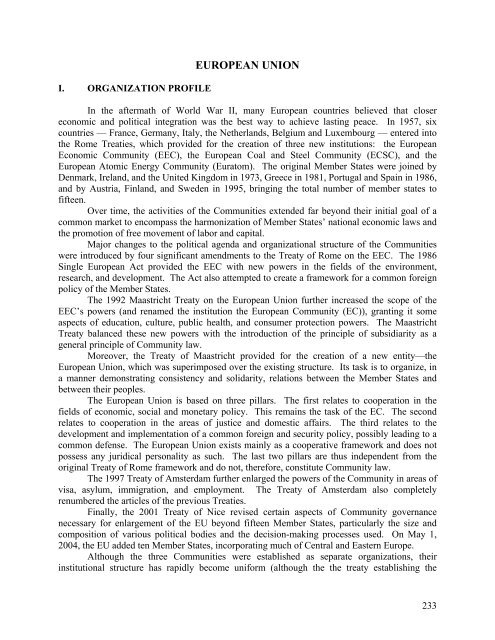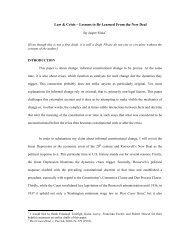Guide to Foreign and International Legal Citations - New York ...
Guide to Foreign and International Legal Citations - New York ...
Guide to Foreign and International Legal Citations - New York ...
Create successful ePaper yourself
Turn your PDF publications into a flip-book with our unique Google optimized e-Paper software.
I. ORGANIZATION PROFILE<br />
EUROPEAN UNION<br />
In the aftermath of World War II, many European countries believed that closer<br />
economic <strong>and</strong> political integration was the best way <strong>to</strong> achieve lasting peace. In 1957, six<br />
countries — France, Germany, Italy, the Netherl<strong>and</strong>s, Belgium <strong>and</strong> Luxembourg — entered in<strong>to</strong><br />
the Rome Treaties, which provided for the creation of three new institutions: the European<br />
Economic Community (EEC), the European Coal <strong>and</strong> Steel Community (ECSC), <strong>and</strong> the<br />
European A<strong>to</strong>mic Energy Community (Eura<strong>to</strong>m). The original Member States were joined by<br />
Denmark, Irel<strong>and</strong>, <strong>and</strong> the United Kingdom in 1973, Greece in 1981, Portugal <strong>and</strong> Spain in 1986,<br />
<strong>and</strong> by Austria, Finl<strong>and</strong>, <strong>and</strong> Sweden in 1995, bringing the <strong>to</strong>tal number of member states <strong>to</strong><br />
fifteen.<br />
Over time, the activities of the Communities extended far beyond their initial goal of a<br />
common market <strong>to</strong> encompass the harmonization of Member States’ national economic laws <strong>and</strong><br />
the promotion of free movement of labor <strong>and</strong> capital.<br />
Major changes <strong>to</strong> the political agenda <strong>and</strong> organizational structure of the Communities<br />
were introduced by four significant amendments <strong>to</strong> the Treaty of Rome on the EEC. The 1986<br />
Single European Act provided the EEC with new powers in the fields of the environment,<br />
research, <strong>and</strong> development. The Act also attempted <strong>to</strong> create a framework for a common foreign<br />
policy of the Member States.<br />
The 1992 Maastricht Treaty on the European Union further increased the scope of the<br />
EEC’s powers (<strong>and</strong> renamed the institution the European Community (EC)), granting it some<br />
aspects of education, culture, public health, <strong>and</strong> consumer protection powers. The Maastricht<br />
Treaty balanced these new powers with the introduction of the principle of subsidiarity as a<br />
general principle of Community law.<br />
Moreover, the Treaty of Maastricht provided for the creation of a new entity—the<br />
European Union, which was superimposed over the existing structure. Its task is <strong>to</strong> organize, in<br />
a manner demonstrating consistency <strong>and</strong> solidarity, relations between the Member States <strong>and</strong><br />
between their peoples.<br />
The European Union is based on three pillars. The first relates <strong>to</strong> cooperation in the<br />
fields of economic, social <strong>and</strong> monetary policy. This remains the task of the EC. The second<br />
relates <strong>to</strong> cooperation in the areas of justice <strong>and</strong> domestic affairs. The third relates <strong>to</strong> the<br />
development <strong>and</strong> implementation of a common foreign <strong>and</strong> security policy, possibly leading <strong>to</strong> a<br />
common defense. The European Union exists mainly as a cooperative framework <strong>and</strong> does not<br />
possess any juridical personality as such. The last two pillars are thus independent from the<br />
original Treaty of Rome framework <strong>and</strong> do not, therefore, constitute Community law.<br />
The 1997 Treaty of Amsterdam further enlarged the powers of the Community in areas of<br />
visa, asylum, immigration, <strong>and</strong> employment. The Treaty of Amsterdam also completely<br />
renumbered the articles of the previous Treaties.<br />
Finally, the 2001 Treaty of Nice revised certain aspects of Community governance<br />
necessary for enlargement of the EU beyond fifteen Member States, particularly the size <strong>and</strong><br />
composition of various political bodies <strong>and</strong> the decision-making processes used. On May 1,<br />
2004, the EU added ten Member States, incorporating much of Central <strong>and</strong> Eastern Europe.<br />
Although the three Communities were established as separate organizations, their<br />
institutional structure has rapidly become uniform (although the the treaty establishing the<br />
233
















